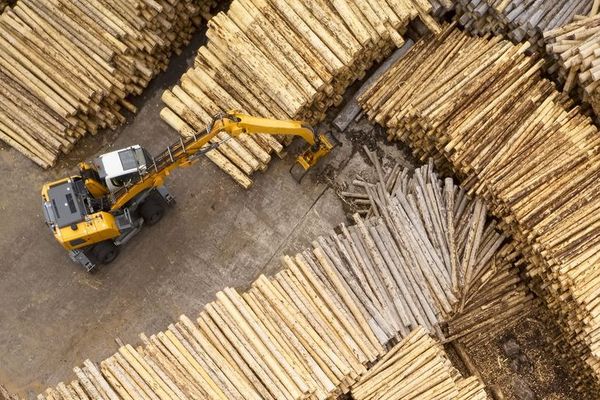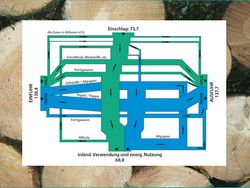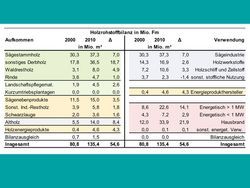Expertise
Wood resource monitoring
Dominik Jochem | 16.08.2022
Wood is one of the most important renewable resources in Germany. But who uses this resource? How is the supply of the different assortments? Available statistics do show considerable gaps of information.
The official statistics, which record the production of sawnwood, wood-based panels and pulp, underestimate the production volumes of the above-mentioned products by up to 20 percent in some cases. In addition, the raw material mix between roundwood, waste wood and residual materials in the case of wood-based panels and pulp is not recorded in the official statistics. In the official statistics on the production of sawnwood, this is mainly due to the fact that small sawmills and small companies do not have to report their production volumes. Also unknown is the wood consumption of private households and biomass plants.
Against this background, the Thünen Institute of Forestry has taken on a new permanent task, which involves supplementing official statistics with its own surveys and estimates. With surveys of, for example, sawmills, biomass plants and private households on wood use, we now regularly collect industry-related data. In this way, a reliable, comprehensive and time-series-capable data basis can be created for monitoring in the wood sector. We can build on many years of work carried out at the University of Hamburg under Prof. Udo Mantau, which we have further developed together with him and his company Informationssysteme für Rohstoffe (INFRO).
The resulting database is used not only by the Federal Statistical Office, but also by Eurostat and the United Nations. The wood resource monitoring serves, among other things, to estimate the use of wood for energy, to better understand material cycles and is thus also suitable for questions of the bioeconomy. It provides essential basic data for the bioeconomy monitoring project in the wood sector.
Current results
The sawmill industry still have the greatest importance for the use roundwood: In 2016, around 36.2 million cubic meters of raw wood were used in sawmills. However, around 18 million cubic meters of roundwood and 10 million cubic meters of other wood based materials, such as wood residues or wood pellets, also end up in the fireplaces of private households. In contrast, waste wood, i.e. wood that has already gone through a use cycle, is mainly burned in large wood-fired power plants (approx. 11 million cubic meters). Only a small part (approx. 2 million cubic meters) goes into the production of particleboards.
2000 | 2010 | 2016 | Application |
|---|---|---|---|
30,3 | 37,3 | 36,2 | Sawmill industry |
14,3 | 16,9 | 15,7 | Wood based panels |
7,2 | 10,6 | 9,8 | Pulp industry |
3,7 | 2,3 | 1,7 | other material use |
0,4 | 4,6 | 4,2 | Energy products |
8,6 | 22,6 | 23,0 | Energetic use > 1MW |
4,3 | 7,2 | 8,2 | Energetic use < 1MW |
12,0 | 33,9 | 28,3 | private Households |
0,0 | 0,1 | 0,0 | other energetic use |
0,0 | 0,0 | 0,1 | Balancing |
80,8 | 135,4 | 127,2 | Total |
The wood resource monitoring also provides important information for estimating the annual fellings in Germany. For the ecalculation of fellings, which was developed with INFRO, we mainly use data from the wood resource monitoring. We combine these with corresponding trade data as well as data on changes in stock levels to determine the wood fellings in Germany.
The amount of annual fellings is the central parameter for the utilization of wood as a resource and is therefore a key indicator for assessing sustainability and estimating the unused roundwood potential. In addition, we use this figure to determine the carbon storage in forests and wood. The official felling statistics significantly underestimate the actual fellings (see figure above).
The analyses show that the official felling statistics only cover about 79 percent of the actual felling (averaged from 1995 to 2021). This means that, on average, about 14.1 million cubic meters of fellings were not recorded each year. On average (2003 to 2012), the results of the recalculation of fellings deviate from the results of the third federal forest inventory by about 1.8 million cubic meters (solid cubic meters without bark) or by about 2.4 percent.
As part of the recalculation of fellings, all roundwood-using sectors are first identified and an analysis of data availability and data quality is carried out. If no official data are available, or the data quality is insufficient, other data sources, such as the wood resource monitoring, association statistics or other empirical studies are used.
Identified data gaps on the use-side are filled by individual sector-specific models. For example, in the sawmill industry, the average yield and the level of coverage of official statistics are estimated. With additional consideration of foreign trade and the changes in roundwood stocks, the fellings can be determined.
Data are used for both national and international reporting. At the national level, it includes e.g. the forest accounts. At the national level, they are also used for the so-called wood balances. At the international level, the data are included in the Joint Forest Sector Questionnaire (JFSQ) and the European Forest Accounts (EFA).











